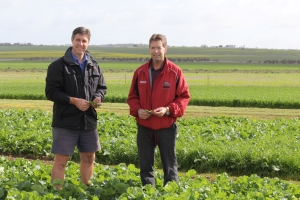
Findings from one of Australia’s longest running paddock surveys have confirmed some plants will change the way they grow and reproduce to avoid all forms of weed control.
“This is one of the first studies in cropping systems to prove the ‘intelligence’ of weed plants, and their ability to evolve over time to evade control strategies in an attempt to survive,” says Australian Herbicide Resistance Initiative (AHRI) research agronomist Mike Ashworth.
“In simple terms, this study has shown us how weeds, particularly wild radish, can evolve and adapt their growth habit or life cycle to evade weed control, not only in regard to herbicide resistance, but also non-herbicide control strategies that growers now use.”
Conversely, the far-reaching study, conducted with investment from the Grains Research and Development Corporation (GRDC), also found a lack of any clear evolutionary response of annual ryegrass to harvest weed seed control (HWSC).
Dr Ashworth, who managed the biological sampling, analysis and interpretation of research findings from the weed control study, says this is exciting news for grain growers because it reaffirms the value of HWSC.
AHRI used the information from long-running paddock surveys, that began in 2001 in Western Australia’s northern agricultural region, to ascertain the evolutionary consequences of weed seed control on long-term weed populations.
Dr Ashworth says one of the most interesting findings highlighted by the research was the ability of wild radish populations to evade HWSC.
“The achilles’ heel of wild radish is that it retains nearly all of its pods on the plant until harvest, making it an ideal candidate for interception and destruction using HWSC,” he says.
Despite this fact, the research has shown that wild radish is capable of responding to HWSC measures by lowering the height of its pods to reduce the number of pods captured at harvest time.
The height of the lowest-retained wild radish pod changed significantly between the in-crop population and the control.
This is important because it directly affects the maximum cutting height and interception efficiency at harvest, with seeds located under a nominal cutting height of 10 centimetres unlikely to be intercepted, thereby replenishing the soil seed bank.
Dr Ashworth says the data indicated the pods in the crop were, on average, 12cm lower than the pods on the plants in the control plots.
The height of the lowest pod in the control population was 20.3cm, while the average lowest pod in the in-crop population was 8.3cm. So, in this situation, HWSC would be less effective, although still worthwhile as significant amounts of seed would still be captured.
In terms of time of flowering, the wild radish patches in-crop flowered 11.5 days earlier than the control populations.
In regard to annual ryegrass, the research demonstrated early flowering time was found in all intense cropping situations but wasn’t directly correlated to the use of HWSC.
Likewise, on all sites, germination percentages of all ryegrass seeds were lower in the intensively managed in-crop samples when compared to the control, indicating there is a shift towards an increase in ryegrass seed dormancy.
What this means for growers, Dr Ashworth says, is while HWSC is effective, so too is an early sown crop to outcompete the ryegrass, particularly those weed seeds that are germinating later.
Dr Ashworth says the intensive research points to a simple message for growers which is to use as much diversity as possible in their weed management strategies.
The only long-term solution, he says, is to continually modify strategies to be one step ahead of this evolutionary process.
The other message, which is just as critical, is for growers to continue to invest in HWSC.
AHRI attracts an annual investment contribution of more than $1.5 million from the GRDC and is based at The University of WA School of Agriculture and Environment.







